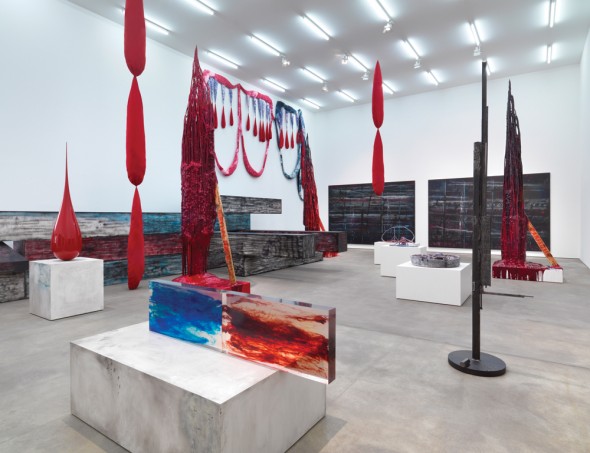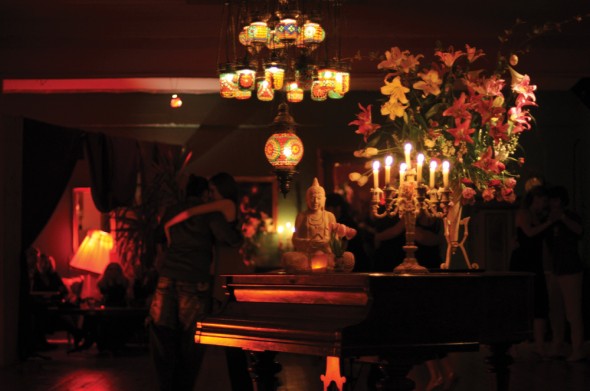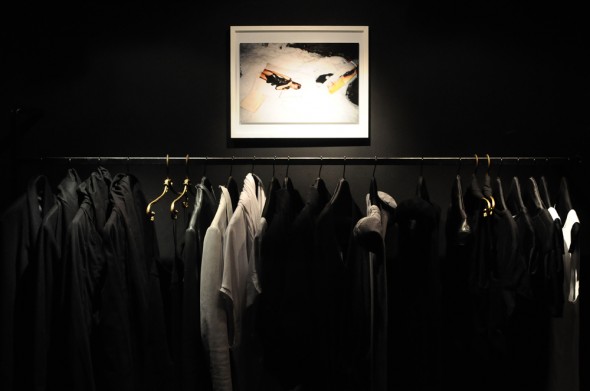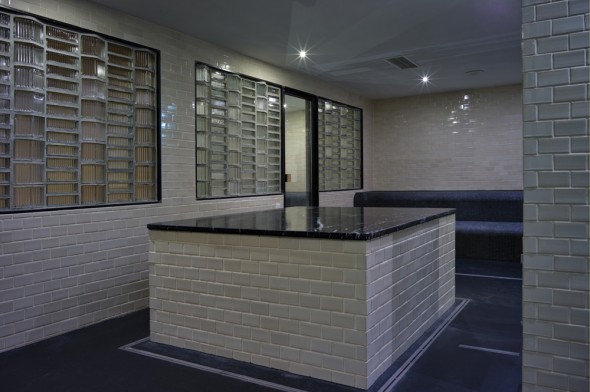
Sterling Ruby, I Am Not Free Because I Can Be Exploded Anytime, Sprüth Magers Berlin, 2011
48 Hours in Berlin
It’s 6p.m. on Saturday and my boss, a 50 yr-old Canadian art dealer, has turned on the techno music, filling the gallery with deafening electro-beats. This announces his plan for the evening: it’s his ritual warm-up before heading to Berghain, Berlin’s most hedonistic nightclub. I’ll probably wind up there too, but luckily our paths won’t cross. He arrives and leaves early, while for me and my 20-something brethren, it’s entirely unacceptable to show up at Berghain until at least 6a.m. This leaves ample time for more civilized social affairs before the entire evening plummets into an abyss of abject debauchery, as most evenings in Berlin tend to do.
As per usual, the night begins innocently enough. I grab my bike (the best way to get around while still sober) and head over to the evening’s art openings, taking place along one of the city’s numerous gallery rows. On any given night in Berlin, there are probably 100 openings (check indexberlin.de for select listings), but only a handful of galleries that never disappoint. Among these are Sprüth Magers (spruethmagers.com), Galerie Max Hetzler (maxhetzler.com) and Contemporary Fine Arts (cfa-berlin.com), all blue-chip galleries showing major contemporary artists.
By now its 9p.m., time for dinner, so I make my way to HBC (hbc-berlin.de), a restaurant/club/event space in the former Hungarian Cultural Center that offers a surreal view of Alexanderplatz, specifically the 13th century Marien Church dwarfed by Berlin’s iconic Soviet-era TV tower. Such juxtapositions are commonplace in Berlin, but that doesn’t make them any less bizarre. It’s a fitting backdrop for the patrons at HBC, an international bohemian crowd dining on Franco-German cuisine in the restaurant’s uber mod interior, before taking to the neon-lit lounge and retro theater for drinks and dancing.
At 11p.m. a friend’s DJ set is beginning at a nearby bar that’s managed to achieve almost overnight ubiquity as the city’s chicest dive, so we jump in a cab and tell the driver “Kurzstrecke,” ensuring that the short trip will only cost a flatrate of four euros. The owners of this particular establishment also runs Grill Royal (grillroyal.com), a pricey riverside steak house frequented by local gliteratti and visiting celebrities. Like Grill, they’ve outfitted their tiny bar, ironically named King Size Bar (kingsizebar.de), with edgy contemporary art by beloved local stars like Katja Strunz. Before long, the space is so crowded that it’s impossible to move, so we fight our way through the throng and emerge breathless on the street, now teeming with drunken students, rowdy tourists and eight-ft tall prostitutes spilling out of painful-looking corsets and armed with fanny packs full of condoms.
Now it’s off to an artist friend’s birthday party at his studio in a former city bathhouse that’s been converted into a cultural center and not-quite-legal nightclub. It’s beyond the fashionable fringes of Mitte, Berlin’s trendiest quarter, so my less ambitious friends stay behind, horrified by the thought of venturing into the gritty depths of Wedding (Mitte’s neighbor to the north).
Stattbad (stattbad.net), as the space is called, hosts exhibitions, performances, concerts and international DJs. I swing by the studio of said friend and make the obligatory toast before heading downstairs into one of the drained swimming pools, now overflowing with hipsters dancing to electro-funk. A performance artist strips, paints her body gold and flings herself into the crowd. No one seems to mind. I run into a group of friends and we descend further into the Stattbad bacchanal, which is just getting started in its labyrinth basement since 2a.m. is still considered early in Berlin.

Tangoloft
At this point, my boyfriend shows up. I had promised (after much resistance) that we would go dancing, in the traditional sense, so we take our leave of Stattbad and walk across the street, following blinking red lights into the courtyard of a post-industrial building. A few stories up, accordion music is emanating from an open window belonging to Tangoloft (tangoloft-berlin.de), a space romantically renovated with salvaged stained glass windows, where tango devotees gather on Saturday nights and Sunday afternoons, circling in candle-light.
After a few songs I’m starving, so we head back towards Mitte to get something to eat. At this hour in the morning there’s not really any restaurants open, but there is a legendary burger stand, Burgermeister (burger-meister.de), that’s open until 4a.m. down in Kreuzberg, just south of Mitte. The venue is less than appetizing—it’s a converted public toilet under the train overpass—but the burgers are divine, explaining the late-night crowd, many of whom are on their way to nearby Watergate (water-gate.de), a sleek riverside club that, despite its relatively sophisticated set-up, refuses entry to anyone wearing a collared shirt. Consider this fair warning.
After a quick disco nap, it’s time to go to Berghain (berghain.de), widely hailed as Europe’s best nightclub. The trick to getting into Berghain is to keep quiet while waiting in line, which is notoriously long unless you go early (midnight) or late (6a.m.). Many an over-eager tourist has waited patiently for over an hour only to be turned away because they drunkenly called attention to themselves, were in a group of more than four, or dressed in anything that could be labeled respectable or, even worse, conventional.

Don't Shoot the Messengers
Why endure the pain of waiting hours on end just to be subjected to arbitrary door politics? Quite simply because Berghain is worth it. Housed in a massive former power plant, the club consists of two main dance floors, one predominantly gay, the other straight, and plenty of dark recesses where things happen that can’t (or at least shouldn’t) be published. For this reason, cameras are confiscated at the door and returned upon exiting. On the upper dance floor, known as Panorama Bar, the industrial window blinds open mid-morning and daylight suddenly floods the club, before the shutters close again and the party continues unabashed without another thought of the world outside. Frequented by people of all ages, ethnicities and sexual preferences, the scene is impossible to classify, but typical for Berlin.
Berliners spend their Sundays brunching lax before shuffling through the flea markets set up all over town. Every demographic has a corresponding flea market. In bourgeois Prenzlauer Berg there’s the Mauerpark and Arkonaplatz markets, the former an overwhelming mass of retro junk that’s prone to hoards, the latter a more manageable, upscale selection of vintage goods including designer furniture and funky accessories stemming from the former East.
After a quick tour, it’s best to recuperate with coffee and cake on the sunny porch of Nola’s (nola.de), a Swiss restaurant decked out chalet-style and perched atop lovely Weinbergspark. Since stores are mostly closed on Sundays, it’s safe to go window shopping on nearby Mulackstrasse, full of trendy high-end fashion boutiques like LaLa Berlin (lalaberlin.com) and Don’t Shoot the Messengers (dont-shoot-the-messengers.com), both local labels.

Cowshed Spa, SoHo House
As a gallery director, I have Mondays off. This time is invariably spent recovering in the Cowshed spa at Soho House (sohohouseberlin.com/cowshed) before meeting up with friends at cozy Neue Odessa Bar (neueodessabar.de). Over drinks we compare notes and congratulate ourselves on surviving yet another weekend of wild excess in beautifully degenerate Berlin. Next thing you know, it’s three in the morning. Thank God I don’t have to be at work until noon.
– Emilie Trice

